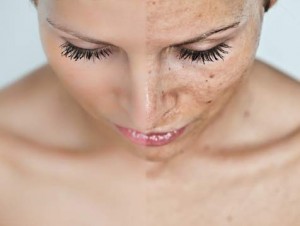Even Out Your Skin Tone with Good Care
Many people develop brown spots on their skin
over time, especially if they've had a trauma to their skin or spent
much time in the sun. The term for these spots is hyperpigmentation,
which describes an excess of pigment in the skin. Often an early sign of
aging, they may first appear on the backs of hands. These spots can be
faded, but patience for the process is required because repeated
treatments will be necessary. It takes regular use of sunscreen to keep
hyperpigmentation from returning. (Note that hyperpigmentation is
different from hypopigmentation, which appears as lighter spots on the
skin).
Hyperpigmentation takes different forms. These include:
Freckles/lentigenes.These are the result of an inherited tendency; exposure to the sun will darken their color.
Solar lentigenes.These darkened spots on the skin that some call age spots indicate overexposure to the sun that has resulted in ultraviolet light damage.
Melasma.Melasma is a response to hormone changes, such as those caused by birth control pills, pregnancy, and menopause, resulting in facial spots.
Postinflammatory hyperpigmentation.This is the direct result of an injury to the skin. The body's response to injury is inflammation. Some think this inflammation reprograms melanocytes to be hyperactive and to produce more melanin. It affects men and women equally. Some common pigmentation- causing injuries include: abrasions, cuts, and wounds; acne lesions and cysts, excoriations (picking pimples); aggressive chemical exfoliation (peels); aggressive extraction; ingrown hairs; insect bites; scratching; sunburn; and waxing.
There is another type of hyper- pigmentation that is more diffused and appears as an overall darkening of the skin, rather than in patches and spots. This condition should be cared for by a dermatologist, as it may reflect a disease or systemic problem, like Addison's disease or scleroderma.)
Hyperpigmentation can be caused by certain prescription drugs, like antibiotics, antidepressants, barbiturates (depressants), and chemotherapy drugs. Some over-the-counter laxatives with phenolphthalein and nonsteroidal anti-inflammatory drugs (NSAIDs), like ibuprofen, can cause hyper- pigmentation. Be sure to record your use of these drugs on the intake form (or on an updated health history) when you arrive and verbally mention them to your esthetician before beginning a treatment.
Occasionally, people mistake darkness under the eyes for hyperpigmentation, but this condition is a reflection of the blood vessels through the surface of the skin. These circles have a variety of causes and can sometimes be treated with peptides.
While hyperpigmentation generally affects all races, some forms of it appear more often with certain skin colors and tones. For example, melasma and postinflammatory hyperpigmentation are more prevalent in darker skin. Solar lentigenes are more prevalent in lighter skin (ninety percent of white adults older than 60 have age spots); they also are more common in women than men.

PreventionIt's very important that you follow the instructions of your skin care professional in preparing for any skin treatments. Your skin care professional will take steps to avoid inducing pigmentation when he or she performs chemical exfoliation, extractions, or waxing. For example, you may be advised to undergo preliminary treatments or to use skin care products, or both, for several weeks before chemical exfoliation (peels) or microdermabrasion. This preparation will reduce the odds of postinflammatory hyperpigmentation and give you better treatment results when you do receive peels or microdermabrasion.
To prevent sun-induced hyper- pigmentation and other skin damage, sunscreen is the most important product to use. Diligent use of sunscreen can prevent further sun damage, but it cannot repair damage already done. Experts strongly recommend using generous amounts of SPF 15 (or higher) sunscreen at all times, reapplying it every few hours. Sunscreens with avobenzone, titanium dioxide, or zinc oxide provide the most complete coverage. Even more importantly, sunscreen reduces ultraviolet light exposure, which reduces the risk of skin cancer.
TreatmentAs a member of Associated Skin Care Professionals (ASCP), your esthetician is prepared to help address questions you have about your skin and to work with you to determine the most useful care that meets your needs. The treatment of brown spots can be highly effective, but it takes a bit of time. Professional treatments for hyperpigmentation may include chemical exfoliation or micro- dermabrasion in combination with topical products. Or, topical treatments may be used alone. Your esthetician can best determine what will bring you the greatest results. Again, following the directions for home care after professional treatments is very important to your success. Make the most of the time and money you've invested in your treatments by following up on your esthetician's instructions.







